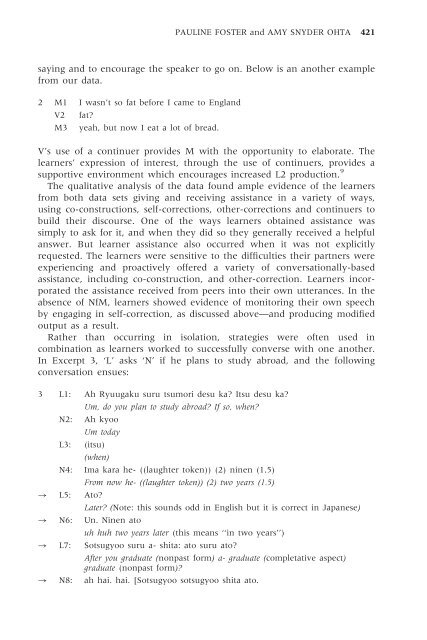Negotiation for Meaning and Peer Assistance in Second Language ...
Negotiation for Meaning and Peer Assistance in Second Language ...
Negotiation for Meaning and Peer Assistance in Second Language ...
Create successful ePaper yourself
Turn your PDF publications into a flip-book with our unique Google optimized e-Paper software.
PAULINE FOSTER <strong>and</strong> AMY SNYDER OHTA 421<br />
say<strong>in</strong>g <strong>and</strong> to encourage the speaker to go on. Below is an another example<br />
from our data.<br />
2 M1 I wasn’t so fat be<strong>for</strong>e I came to Engl<strong>and</strong><br />
V2 fat?<br />
M3 yeah, but now I eat a lot of bread.<br />
V’s use of a cont<strong>in</strong>uer provides M with the opportunity to elaborate. The<br />
learners’ expression of <strong>in</strong>terest, through the use of cont<strong>in</strong>uers, provides a<br />
supportive environment which encourages <strong>in</strong>creased L2 production. 9<br />
The qualitative analysis of the data found ample evidence of the learners<br />
from both data sets giv<strong>in</strong>g <strong>and</strong> receiv<strong>in</strong>g assistance <strong>in</strong> a variety of ways,<br />
us<strong>in</strong>g co-constructions, self-corrections, other-corrections <strong>and</strong> cont<strong>in</strong>uers to<br />
build their discourse. One of the ways learners obta<strong>in</strong>ed assistance was<br />
simply to ask <strong>for</strong> it, <strong>and</strong> when they did so they generally received a helpful<br />
answer. But learner assistance also occurred when it was not explicitly<br />
requested. The learners were sensitive to the difficulties their partners were<br />
experienc<strong>in</strong>g <strong>and</strong> proactively offered a variety of conversationally-based<br />
assistance, <strong>in</strong>clud<strong>in</strong>g co-construction, <strong>and</strong> other-correction. Learners <strong>in</strong>corporated<br />
the assistance received from peers <strong>in</strong>to their own utterances. In the<br />
absence of NfM, learners showed evidence of monitor<strong>in</strong>g their own speech<br />
by engag<strong>in</strong>g <strong>in</strong> self-correction, as discussed above—<strong>and</strong> produc<strong>in</strong>g modified<br />
output as a result.<br />
Rather than occurr<strong>in</strong>g <strong>in</strong> isolation, strategies were often used <strong>in</strong><br />
comb<strong>in</strong>ation as learners worked to successfully converse with one another.<br />
In Excerpt 3, ‘L’ asks ‘N’ if he plans to study abroad, <strong>and</strong> the follow<strong>in</strong>g<br />
conversation ensues:<br />
3 L1: Ah Ryuugaku suru tsumori desu ka? Itsu desu ka?<br />
Um, do you plan to study abroad? If so, when?<br />
N2: Ah kyoo<br />
Um today<br />
L3: (itsu)<br />
(when)<br />
N4: Ima kara he- ((laughter token)) (2) n<strong>in</strong>en (1.5)<br />
From now he- ((laughter token)) (2) two years (1.5)<br />
! L5: Ato?<br />
Later? (Note: this sounds odd <strong>in</strong> English but it is correct <strong>in</strong> Japanese)<br />
! N6: Un. N<strong>in</strong>en ato<br />
uh huh two years later (this means ‘‘<strong>in</strong> two years’’)<br />
! L7: Sotsugyoo suru a- shita: ato suru ato?<br />
After you graduate (nonpast <strong>for</strong>m) a- graduate (completative aspect)<br />
graduate (nonpast <strong>for</strong>m)?<br />
! N8: ah hai. hai. [Sotsugyoo sotsugyoo shita ato.














